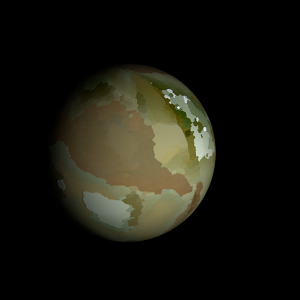|
|
Space Astro
|
Info for exoplanet "Wanlai"
| Scientific (actual) data |
|---|
| Name | Kepler-1299 b |
| Planet status | Confirmed |
| Radius | 0.266 |
| Orbital period | 19.9401 |
| Discovered | 2016 |
| Updated | 2021-02-05 |
| Tconj | 2454980 |
| Publication | Announced on a website |
| Detection type | Primary Transit |
| Alternate names | 2MASS J19043603+3724409 b, K02634.01, KIC 1995519 b, KOI-2634 b, KOI-2634.01 |
| Star name | Kepler-1299 |
| Right ascension | 286.15° |
| Declination | 37.41° |
| Mag j | 14.644 |
| Mag h | 14.284 |
| Mag k | 14.191 |
| Star distance | 1352 |
| Star metallicity | -0.01 |
| Star mass | 0.94 |
| Star radius | 0.91 |
| Star age | 4.37 |
| Star temperature | 5609 |
| Star alternate names | 2MASS J19043603+3724409, KIC 1995519, KOI-2634 |
| Wikipedia article | Kepler-1299 b |
Back
| |
| Fictional info (?) |
|---|
| Suggested name | Wanlai |
| Planet type | Cold planet |
| The methane has probably photodissociated, and the free water has been swept into interplanetary space by the solar wind because of the lack of a carbon dioxide layer.
Surface inhabitated by friendly but shy and primitive herbivores that feed hidden in craters while killing plants They are believed to be somewhat related to Yizo'kouk and have wings and vary in size from 3 to 6 cm. Most Keikyo Lyun can reproduce at temperatures from 90 to 140°C and even high atmospheric pressure. |
| Estimated population | 1200000000 |
| Atmosphere | Water | 61% |
| Oxygen | 35% |
| Methane | 4.1% |
| Carbon dioxide | 0% |
| Atmospheric pressure | 0.5 bar |
 |
| Moon | Yangbex'yonying | Huge almost round ice planetoid |
| Yizhya | Very small potato shaped ice moon |
| Youdyue | Very small slightly egg-shaped rocky planetoid |
| Ceng | Large irregular oceanic comet |
| Yuanhai-s | Small potato shaped crater-filled asteroid |
| Wend | Very small irregular ice asteroid |
| Wamyin | Small irregular crater-filled moon |
| Yachyaf-ying | Very small almost round oceanic comet |
| Ouleng | Huge round rocky moon |
| Yunp-wawwant | Small slightly egg-shaped gaseous asteroid |
| Enyao'xerxyang | Medium-sized round oceanic planetoid |
| Rayyan | Medium-sized slightly egg-shaped crater-filled moon |
| Langpya | Medium-sized round ice planetoid |
| Weimyouf | Large almost round ice asteroid |
| Pezh You | Large irregular rocky comet |
| Qenglyu Gyisai-d | Small potato shaped rocky moon |
| Yuwwa-k | Medium-sized irregular rocky comet |
| Gweijou Fyanb | Very small slightly egg-shaped ice planetoid |
| Jwengm Yaojyong | Small slightly egg-shaped rocky moon |
| Xwaijyao Fyaco | Huge potato shaped crater-filled comet |
| Danryuan | Large round rocky moon |
| Yinyanb | Small round crater-filled moon |
| Yanfyue-cwai | Small round rocky moon |
| Yupan | Medium-sized slightly egg-shaped oceanic moon |
| Google search for Wanlai |
|
Website by Joachim Michaelis
|
|
|
|